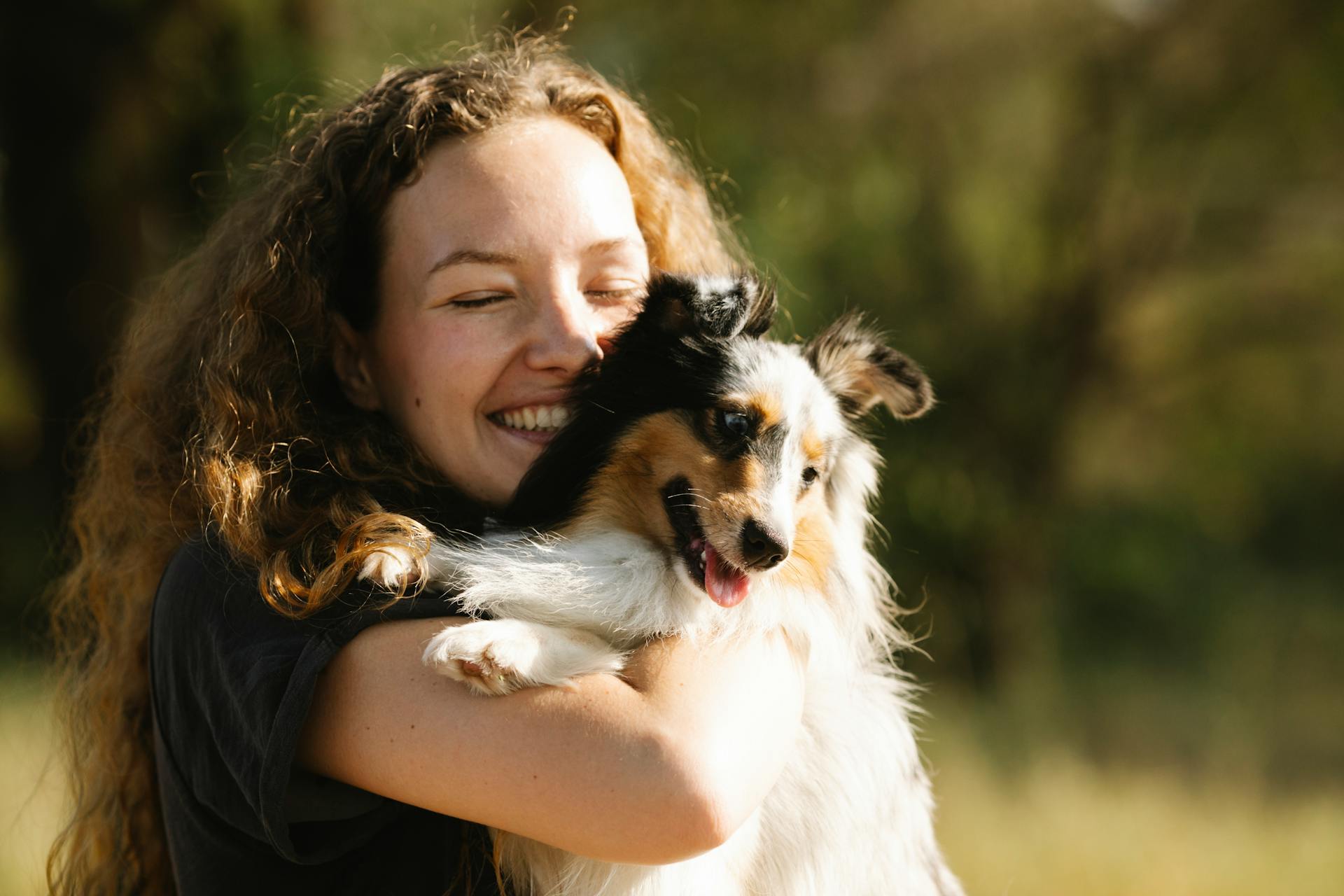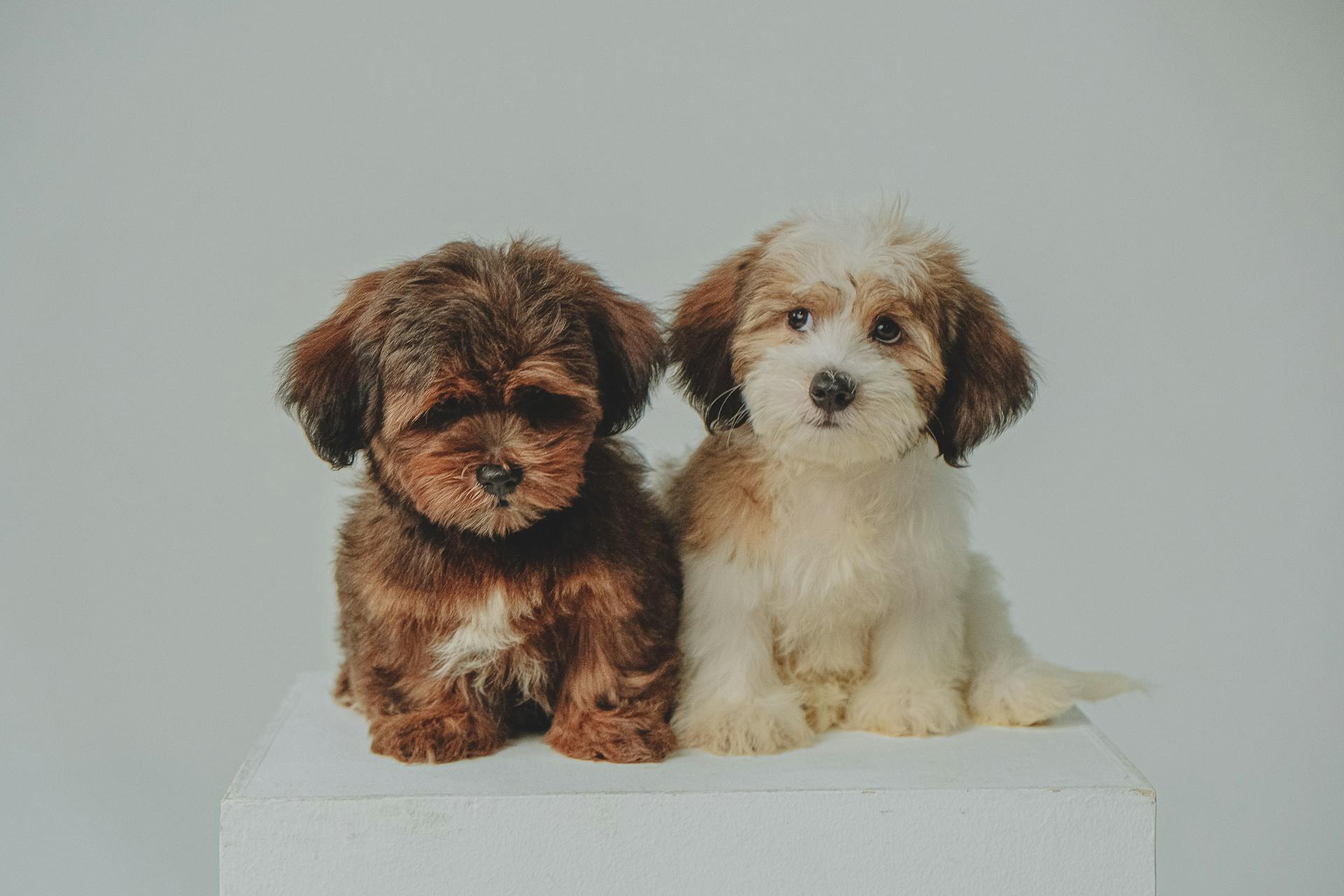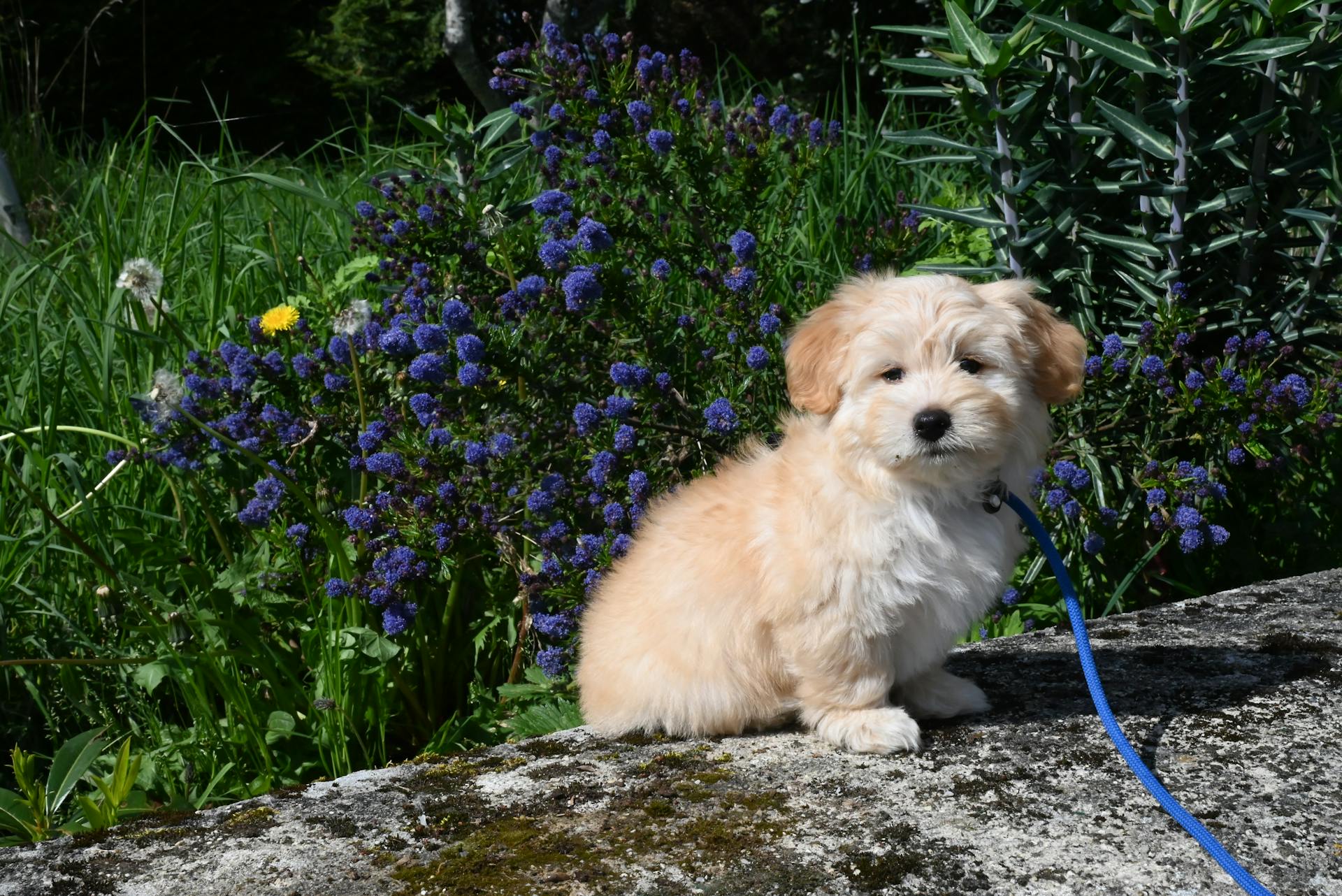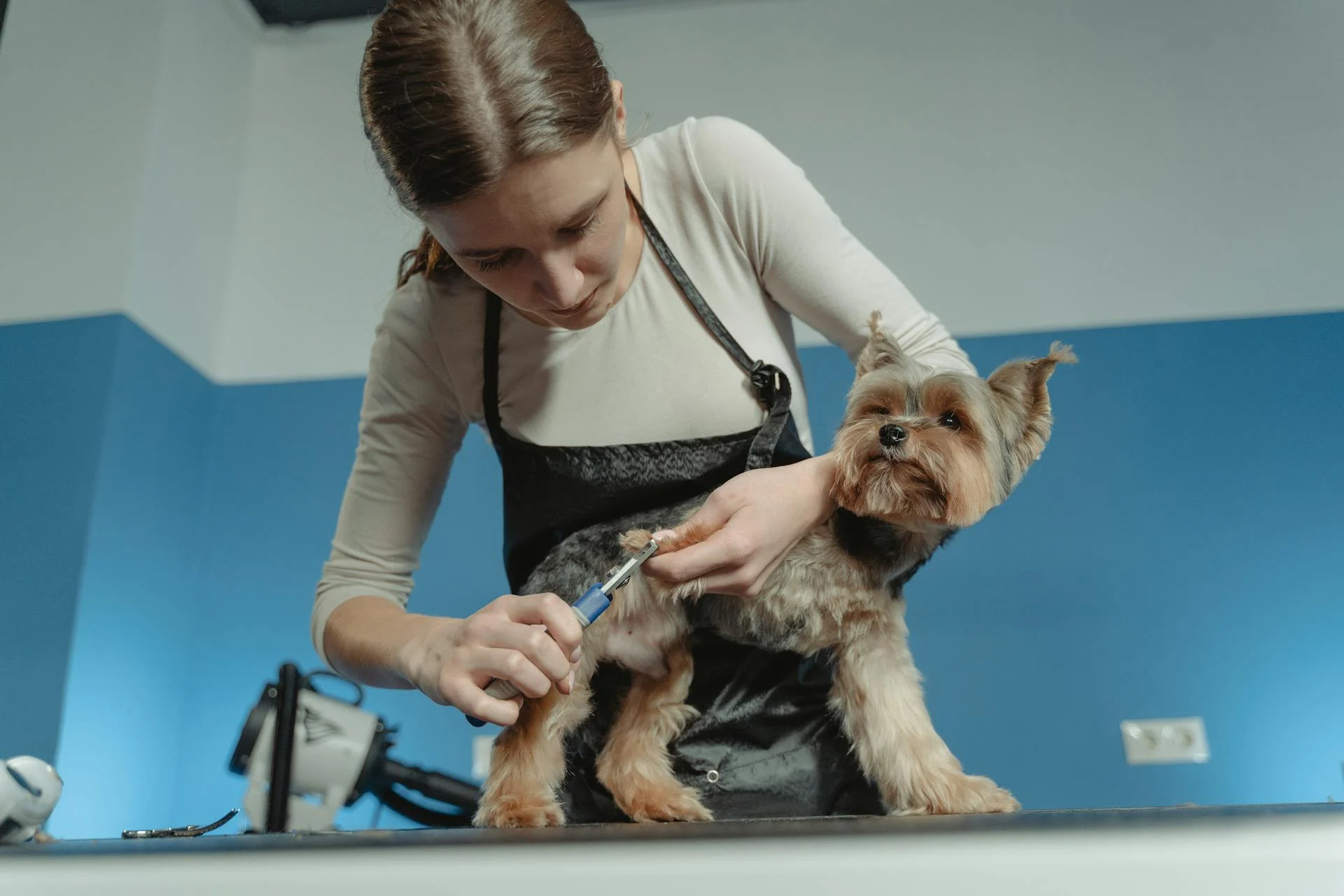
The Havanese dog is a small, playful breed that originated in Cuba. They were originally bred as companions for the Cuban aristocracy.
These dogs are known for their silky, double coats which require regular grooming to prevent matting. Their coats come in a variety of colors, including white, cream, and fawn.
The Havanese is a highly intelligent breed that thrives on attention and interaction. They are naturally curious and love to explore their surroundings.
Their friendly and outgoing personalities make them a great fit for families with children.
Consider reading: American Bully Coats
Quick Facts
The Havanese dog is a wonderful breed with some amazing characteristics. They have a long, silky, and soft double coat that requires regular brushing and occasional professional grooming.
They originated in Cuba and are part of the Toy Group, which means they're small in size. Havanese dogs typically live for 14-16 years, making them a long-term companion.
Their temperament is one of their best features - they're playful, affectionate, intelligent, and friendly. This makes them a great addition to any family.
Here are some key exercise needs to keep in mind: Moderate exercise requirements mean daily walks and playtime are a must.
Training is also important, and Havanese dogs respond well to positive reinforcement and gentle training methods. However, they can be a bit stubborn at times, so patience is key.
As for grooming, regular brushing is a must, and occasional professional grooming is also required.
Breed Information
The Havanese dog is a small but mighty breed that's perfect for families and first-time dog owners. They typically weigh between 6.6-15 pounds and stand between 9-11 inches tall.
One of the most distinctive features of the Havanese is their coat, which comes in a variety of colors including white, brown, red, gray, dun, and black. They have a long, silky, soft double coat that requires regular grooming.
Havanese dogs are known for their friendly and social nature, and they're often described as "Velcro dogs" because they love to stick close to their owners. They're also highly intelligent and trainable, making them a great choice for first-time dog owners.
A different take: Is Lhasa Apso Good for First Time Owners
Here are some key characteristics of the Havanese breed:
Havanese dogs are generally healthy and long-lived, with an average lifespan of 14-16 years. However, like all breeds, they can be prone to certain health issues, so it's essential to work with a reputable breeder who prioritizes health testing and genetic diversity.
In terms of exercise needs, Havanese dogs require moderate exercise to stay happy and healthy. This can include daily walks, playtime, and training sessions. With their high energy levels and love of play, it's essential to provide them with plenty of opportunities to run around and have fun.
Grooming and Appearance
The Havanese coat is a standout feature of this breed, with its soft, silky, and luxurious texture. It's available in a wide range of colors and markings, from pure white to gray, brown, and black.
Their coats can grow quite long, requiring nightly brushing to keep them tangle-free and mat-free. Some owners choose to keep their Havanese's coat short for ease of care, while others opt for a corded coat that requires regular wetting and drying to prevent mildew.
Havanese dogs have expressive eyes and a charming long coat, which also serves as a natural sunscreen. Their silky fur keeps them cool in warm weather, making a longer coat a comfortable choice.
Additional reading: German Shorthaired Pointer Free to Good Home
Size
Havanese dogs stand 8 1/2 to 11 1/2 inches tall.
Their weight can vary, ranging from 7 to 13 pounds.
Adult Havanese dogs are about 8-12 inches high.
Their sturdy bodies make them great companions.
Havanese tails curl up over their bodies.
Discover more: Two Dog Names
Appearance
The Havanese coat is truly one of its standout features, with a silky, soft, and light texture that doesn't shed easily.
Their coats come in a variety of colors and markings, including white, black, black and tan, sable, gray, and many others.
The ideal coat type for the show ring is wavy, but owners can choose to clip their coat short for easier care.
Their coats can grow quite long, requiring daily brushing to prevent mats from forming and frequent baths to keep them clean.
Their silky fur actually serves as a sunscreen, keeping them cool in warm weather.
Their expressive eyes are another special feature of the Havanese breed, and owners should keep the hair above their eyes tied up to prevent irritation.
Tearstains are common in Havanese, but most are not serious and can be improved by keeping the hair around the eyes clean.
Regular nail trimming is essential to prevent scratching and keep their feet in good condition.
Their teeth should be brushed at least two or three times a week to remove tartar buildup and bacteria.
Their sturdy bodies and up-for-anything attitude make them great companions, and they come in a range of colors, from pure white to grey, brown, and black.
Do Dogs Shed?
Dogs do shed, but some breeds are more prone to heavy shedding than others.
Havanese dogs, for example, do shed, but their long double coat traps the shedded hair, making daily brushing crucial for preventing mats and tangles.
Golden retrievers and Labrador retrievers, on the other hand, shed heavily, leaving clumps of fur all over the house.
Regular grooming is essential for maintaining a dog's overall appearance and preventing excessive shedding.
Daily brushing can help reduce shedding and prevent mats and tangles in breeds with long coats, like the Havanese.
You might enjoy: Size of a Labrador Dog
Training and Behavior
The Havanese dog is a highly trainable breed that thrives on human companionship. They are natural trick dogs and excel with patience and positive reinforcement.
To ensure your Havanese becomes a great companion, it's essential to socialize them early on. This means exposing them to various people, sights, sounds, and experiences when they're young. Socialization helps prevent anxiety towards other pets, children, or strangers.
Havanese puppies with nice temperaments are curious and playful, willing to approach people and be held by them. Look for a puppy that's not too aggressive or too shy, and always meet at least one of the parents to ensure they have a good temperament.
Early socialization is key, and enrolling your puppy in a puppy kindergarten class is a great start. Inviting visitors over regularly, taking them to busy parks, and on leisurely strolls to meet neighbors will also help them polish their social skills.
Havanese dogs can suffer from separation anxiety and stress when left alone for too long. This is because they are so devoted to their people and love being around them. To minimize this, consider crate training and including them in your everyday activities.
Here are some tips to help your Havanese feel more comfortable when left alone:
- Crate training can help reduce separation anxiety
- Include them in your everyday activities
- Gradually increase alone time to prevent anxiety
- Provide plenty of exercise and mental stimulation before leaving them alone
By following these tips and socializing your Havanese early on, you can help them become a well-rounded and happy companion.
Health and Care
A Havanese's long lifespan of 14-16 years is due to their generally healthy breed status. Regular veterinary check-ups are essential to detect any potential health issues early.
Havanese dogs require daily brushing to prevent matting of their long coat, and frequent bathing is also necessary. Many owners opt for regular clipping or hire a professional to make grooming easier.
The Havanese is prone to eye disorders, deafness, heart murmurs, Legg-Calve-Perthes disease, and patellar luxation. Annual testing for the eyes and ears, plus X-rays of the hips and knees, can help screen for these conditions.
Here's a list of common health issues to watch out for in Havanese dogs:
- Eye disease (e.g. cherry eye, progressive retinal atrophy, degeneration)
- Deafness
- Legg-Calve-Perthes disease (hip pain and lameness)
- Patellar luxation (dislocated knee cap)
- Chondrodysplasia (abnormal cartilage and bone development in the limbs)
Health and Care

The Havanese is a generally healthy breed with a long lifespan of 14-16 years, but they can be prone to certain health issues. They need regular veterinary check-ups to ensure they're healthy.
Their long coat requires daily brushing to prevent matting, and frequent bathing is necessary to keep them clean. Many owners opt for regular clipping or visiting a professional groomer to make care easier.
Annual testing for eye and ear health, as well as X-rays for hip and knee issues, can help identify potential problems early on. This includes screening for eye diseases, deafness, Legg-Calve-Perthes disease, patellar luxation, and chondrodysplasia.
Havanese dogs need regular exercise to keep them happy and healthy. A daily walk or playtime is essential, but they're not suited for life in the backyard. They thrive in indoor environments and require attention from their owners.
Crate training is a must for Havanese puppies, especially to prevent separation anxiety. With patience and proper training, they can learn good canine manners and become well-behaved companions.

Here are some common health conditions to be aware of in Havanese dogs:
- Eye disease (e.g., cherry eye, progressive retinal atrophy, degeneration)
- Deafness
- Legg-Calve-Perthes disease (hip pain and lameness)
- Patellar luxation (dislocated knee cap)
- Chondrodysplasia (abnormal cartilage and bone development)
Health insurance or a pet savings account can help reduce out-of-pocket expenses in case of accidents or unexpected health issues. It's essential to sign up for these services early to reap the benefits.
Exercise Needs
The Havanese may be small, but they're not lap dogs - they have as much energy as a large dog and need just as much exercise. They have a particularly light-footed, elastic, bouncy gait that's quite adorable.
A daily walk or quick game of catch in the backyard is a great way to keep your Havanese happy and healthy. Pay attention to your pup for any signs of exertion, like excessive panting.
They can thrive in any environment, whether it's a house, apartment, city, or country, as long as they're with their humans. Just be sure not to leave them alone for too long, as they're attention-seeking dogs.
A unique perspective: Dogs Breeds That Start with B
Care and Feeding
The Havanese is a small but energetic breed that requires regular exercise to stay happy. A lengthy walk or an active game of fetch each day is a must.
Housetraining can be challenging, so be prepared to be patient and use crate training to help with this process. You'll need to put your Havanese in a crate with plenty of sturdy toys to keep him occupied when you're not home.
A Havanese's diet is also important, with a recommended daily amount of 1/2 to 1 cup of high-quality dry food, divided into two meals. The quality of dog food makes a difference, and a highly active dog will need more food than a couch potato dog.
Daily brushing is necessary to prevent matting of the Havanese's long coat, and regular bathing is also required. Many owners clip the coat regularly or let a hairdresser clip it to make care easier.
If this caught your attention, see: Will Shiba Inu Ever Reach 1 Cent
Diet and Nutrition
Feeding your Havanese is a crucial part of their care, and it's essential to get it right. The recommended daily amount is 1/2 to 1 cup of high-quality dry food a day, divided into two meals.
You should measure your dog's food and feed them twice a day rather than leaving food out all the time. This will help keep your Havanese in good shape.
As your Havanese grows, their feeding needs will change. Havanese puppies should eat three times a day. At around three months, you can increase the amount and reduce the frequency to twice a day.
To ensure your Havanese is at a healthy weight, perform the eye test and the hands-on test. You should be able to see a waist and feel but not see their ribs without having to press hard. If you can't, they need less food and more exercise.
Check this out: Could Shiba Inu Hit $1
Caring for Your
Caring for your Havanese requires a daily commitment to grooming, with daily brushing necessary to prevent matting of their long coat. This will also help prevent the need for frequent baths.

A lengthy walk or active game of fetch each day will keep your Havanese happy and exercised. You'll need to be patient during the housetraining process, as it can be particularly challenging for this breed.
Crate training is a must for Havanese puppies, as it will help prevent separation anxiety and destructive behavior when left alone. Don't leave your dog alone for long periods of time, and when you do, put him in a crate with plenty of sturdy toys to keep him occupied.
You'll need to make regular trips to the vet for vaccinations, and schedule a haircut or clipping of their coat to make grooming easier. Havanese aren't known for being mischievous, so puppy-proofing your home should be a breeze, but still take the necessary steps to ensure your home is safe for your new pet.
Health insurance or a pet savings account can help reduce out-of-pocket expenses in case of accidents or unexpected health issues. Sign your pet up early to reap the greatest benefits.
On a similar theme: Can Maltese Dogs Be Left Alone
Frequently Asked Questions
What two breeds make a Havanese?
The Havanese breed is believed to be a cross between the Blanquito and the poodle. This cross-bred heritage is thought to have originated from the combination of the Blanquito and other bichon types.
Why are Havanese dogs so expensive?
Havanese dogs are expensive due to the high costs of caring for their puppies, including medical expenses and grooming needs. The average cost of purchasing a purebred Havanese puppy is around $3500-$5000.
Do Havanese bark a lot?
Havanese dogs are generally quiet and rarely bark, except to alert their owners to new arrivals. They make good watchdogs, but only if you're paying attention!
What is the breed standard for Havanese?
The breed standard for Havanese is a height range of 8½ to 10½ inches, with a preferred weight of 7-14 pounds. Weight under 7 or over 14 pounds is considered a disqualification.
What is the life expectancy of a Havanese?
A Havanese's average life expectancy is 14.5 years, with a typical range of 13 to 16 years. Females tend to live about a year longer than males.
Featured Images: pexels.com


